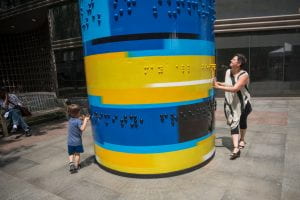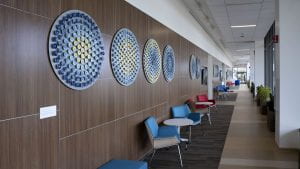
Penn State Behrend’s Campus Arts project began in January of 2019, when it was announced that arts administration (ARTSA) students would be partnering with plastics engineering students(PLET). From the start this was a very exciting undertaking. Not only would we be involved with every step in the process of a large university-wide art project, but in our case, one that could potentially help bridge the social gap many students experience between humanities and sciences/engineering.
Coordinated by Matthew Levy, arts administration chair and art history professor at Penn State Behrend, ARTSA students had a hand in the project from the beginning. Our first experience was a Zoom meeting with the Campus Arts Initiative staff. We paticipated alongside professors Jason Williams and Jonathan Meckley of the plastics engineering department and Eric Corty of humanities and social sciences. During the Zoom meeting we learned about the scope of the project and discussed budgets, plans for choosing artists and a general direction for the Behrend campus project specifically. It was very interesting to see all of the work that goes into a project of this scale, especially when taking into consideration the seven other projects within the Campus Arts Initiative. As arts administration students, we gained real world experience and insight into the type of planning and coordination needed in our future careers.

The next step following our first conference was to begin the artist selection process. We sent out a call for artists with an application including requests for bios, examples of previous work and a statement of interest. A pool of finalists were identified by a jury process on the University Park campus that involved all partners and invited jury members. Each student and faculty member involved on the Behrend campus had the chance to select their number one artist as well as several secondary choices. A follow-up conference involved tallying votes for each artist until we decided upon 3-5 finalists to interview. It was great to hear my fellow students’ and faculty members’ opinions and how they felt each artist could fit our unique situation and project direction. I personally appreciated the input from the plastics department and the unique perspectives they brought to the conversation.
All of this lead up to artist interviews. We video-interviewed our finalists about their work and how they would manage a project of this scale and direction. Following the interviews and a discussion, our choice was nearly unanimous. We selected Lauren Herzak-Bauman for several reasons. The first and foremost of these was her project history and intent in creating artwork. Lauren seeks to connect people through art, an idea we had discussed since the beginning of this project. In Lauren’s initial letter as part of her application, she writes “I see the importance of creating an aesthetic and artistic experience for people inhabiting an environment by choice or by need. There is a language of material that can speak to everyone.” We all agreed that this perspective, present in all of her work, was exactly what we were looking for. Not only that, but many of her works, such as Anicca, pictured below, take on the form of many repeated modules creating a single unified piece. This method of working lends itself very well to the plastics engineering process. She could design a module and have multiples manufactured in the plastics lab fairly easily, later combining them into a finished piece in her studio.

Once we selected Lauren for our project, we invited her onto campus for a tour. This was personally one of my favorite stages of the process. Not only were we introduced to the artist, but also to our peers in the plastics engineering department. We showed Lauren around campus, giving her insight into student life, our experiences at Behrend and the places that mean the most to us. We also got to know fellow students outside of our own department . We gained an understanding and respect for each others’ work. Again, this brings us back to the idea of bridging that gap. Many students from seemingly unrelated disciplines often believe they have nothing in common and, in some cases, may even feel at odds with one another. By collaborating on a project such as this, we are already gaining an understanding of each other and working together towards a common goal.
